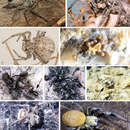Stegodyphus mimosarum: Brief Summary
(
anglais
)
fourni par wikipedia EN
Stegodyphus mimosarum, the African social velvet spider, is a species of the genus Stegodyphus, one of the velvet spiders. It is a social species, which is found in South Africa and Madagascar. The genome sequence was published in 2014. Similar to closely related species such as Stegodyphus sarasinorum, S. mimosarum engages in communal living which involves remaining with the same colony even when prey availability is low, moving away in order to expand the nest not due to lack of food.
- licence
- cc-by-sa-3.0
- droit d’auteur
- Wikipedia authors and editors
Stegodyphus mimosarum: Brief Summary
fourni par wikipedia FR
Stegodyphus mimosarum est une espèce d'araignées aranéomorphes de la famille des Eresidae.
- licence
- cc-by-sa-3.0
- droit d’auteur
- Auteurs et éditeurs de Wikipedia
Description
(
anglais
)
fourni par Zookeys
Male (Forêt d’Analalava, Madagascar, CASENT 9005869, CAS): Carapace with band of white setae around margin, longitudinal line in cephalic region and patches near PLE; cephalic region subtriangular, longer than wide, moderately raised; AME distinctly smaller than PME (AME/PME 0.62), median eyes separated on horizontal axis, largely overlapping on vertical axis; ALE on small tubercles; PER much narrower than AER (PER/AER 0.76), PLE position on carapace 0.32; clypeal hood forms acute angle; fovea shallow. Chelicerae with lateral boss, slightly excavated mesally. Legs with patches and longitudinal bands of white setae; leg I thickened with thick brush of dark setae on femur and especially tibia; with row of distal ventral macrosetae on metatarsus I–IV, a few scattered ventral macrosetae on tarsus I–IV and metatarsus II–IV. Dorsum of abdomen with median longitudinal stripe and posterior patch of white setae (Figs 11E, F, 84A–D).
Male palp with proximal-distal axis; tegulum subtrapezoidal; conductor and embolus together form apical complex making one helical turn; conductor with more or less membranous and papilliated inner layer extending beyond moderately sclerotized outer layer; embolic division longer than tegular division; cymbium with several prolateral macrosetae (Figs 15G–I, 84I, J, 85A–D).
Female (Forêt d’Analalava, Madagascar, CASENT 9005869, CAS):Carapace with band of white setae around margin, densely mixed in cephalic region, fewer in thoracic region mesal to lateral band; cephalic region subtrapezoidal, longer than wide, moderately raised; AME distinctly smaller than PME (AME/PME 0.69), median eyes separated on horizontal axis, largely overlapping on vertical axis; ALE on small tubercles; PER much narrower than AER (0.77), PLE position on carapace 0.27; clypeal hood forms acute angle; fovea shallow. Chelicerae contiguous mesally, with lateral boss. Legs with patches of white setae; with row of distal ventral macrosetae on metatarsus I–IV, scattered ventral macrosetae on tarsus I–IV and metatarsus II–IV. Dorsum of abdomen with alternating light and dark longitudinal bands (Figs 11G, H, 84E–H).
Epigynum bell-shaped with fleshy, bell-shaped median lobe, higher posteriorly than anteriorly, anteriomedian part with notch-shaped invagination (Figs 18H, 86A). Vulva with spermathecal heads on compact sinuous stalks leading to multilobed spermathecae posteriorly (Figs 18K, 86B–D).
- licence
- cc-by-3.0
- droit d’auteur
- Jeremy A. Miller, Charles E. Griswold, Nikolaj Scharff, Milan Řezáč, Tamás Szűts, Mohammad Marhabaie
- citation bibliographique
- Miller J, Griswold C, Scharff N, Řezáč M, Szűts T, Marhabaie M (2012) The velvet spiders: an atlas of the Eresidae (Arachnida, Araneae) ZooKeys 195: 1–144
- auteur
- Jeremy A. Miller
- auteur
- Charles E. Griswold
- auteur
- Nikolaj Scharff
- auteur
- Milan Řezáč
- auteur
- Tamás Szűts
- auteur
- Mohammad Marhabaie

